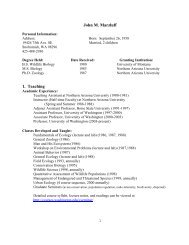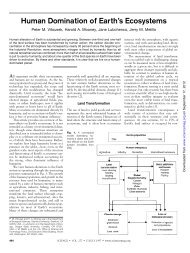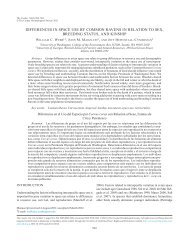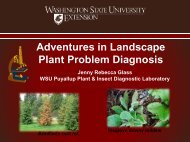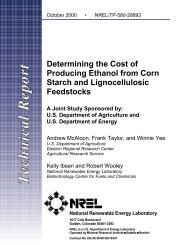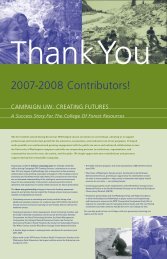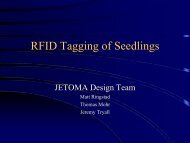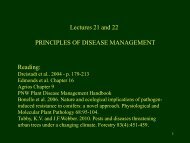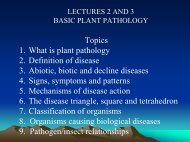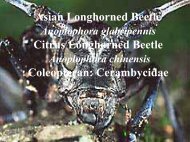You also want an ePaper? Increase the reach of your titles
YUMPU automatically turns print PDFs into web optimized ePapers that Google loves.
Ch14 10/5/99 2:19 PM Page 334<br />
334 CHAPTER 14<br />
Figure 14.1<br />
Excessive brooming on a ponderosa<br />
pine tree in eastern Oregon caused by<br />
western dwarf mistletoe (Arceuthobium<br />
campylopodum).<br />
firs. Typically true mistletoes do not occur north of 40 to 45 ° north latitude (i.e.,<br />
across the United States from Oregon to New Jersey). They have well-developed<br />
stems with leaves 2.5 to 5 cm long. Seeds are disseminated by birds feeding on<br />
their berries. Infected branches typically have galls and brooms. True mistletoes<br />
can be managed by branch pruning and spraying where the value of trees is very<br />
high, such as fruit trees.<br />
Dwarf misletoes are a particular problem in western North America, infecting<br />
Douglas-fir, pines, firs, spruces, hemlocks, and western larch (Hawksworth and<br />
Wiens 1996). They occur from Mexico northward to Canada and across Canada<br />
to the northeastern United States. Species and hosts are listed in Table 14.1. At least<br />
47 species are known from Central and North America, Europe, Africa, Asia, the<br />
Azores, and Caribbean Islands. Many are host-specific, like Douglas-fir dwarf<br />
mistletoe, but some occur on several hosts. For example, A. campylopodum<br />
occurs on Jeffrey and ponderosa pines, and A. tsugense subsp. tsugense occurs on<br />
western hemlock, true firs, and lodgepole pine.<br />
Arceuthobium spp. are dioecious plants without true leaves. A typical life<br />
cycle is shown in Figure 14.2. Seed dispersal normally occurs in the later summer<br />
or fall. Local dispersal occurs when seeds are shot from mistletoe plants at<br />
velocities as high as 100 kph. Seed dispersal range is usually 6 to 11 m, but some<br />
seeds may travel as far as 15 m. Birds or rodents are capable of carrying seeds long<br />
distances to initiate new infection centers. Seeds have a viscous coat, enabling<br />
them to stick on the host. They commonly overwinter on needles and germinate<br />
in the spring. The radicle produced by the seed grows until it reaches a suitable<br />
bark crevice, bud, or needle base. A holdfast forms that completes the infection<br />
process by wedging into the host tissues and producing an extensive haustorial<br />
absorptive system. These “sinkers” penetrate the xylem of the host and are subsequently<br />
embedded by additional growth of xylem tracheids to which they are<br />
connected. Infected branches are typically swollen and distorted and are commonly<br />
called witches’-brooms. Infections may be localized or systemic.



